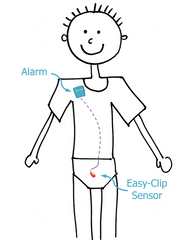Should I choose a wearable or wireless alarm?
Here, at The Bedwetting Doctor, we stock a huge range of bedwetting alarms. All these alarms work in the same way to cure bedwetting - by waking a child as soon as they start wetting the bed. However, to maximise the alarm’s effectiveness, it is important to choose the right alarm to ensure that it suits each individual child.
Wearable or Wireless?
Our alarms fall into two broad categories: wearable alarms and wireless alarms. When choosing which alarm would suit your child best, this is the first decision to make.
Wearable Bedwetting Alarms
The wearable bedwetting alarm was invented by Dr Malem in the 1970s. Now, nearly 40 years later, wearable bedwetting alarms offer the most advanced and comprehensive features of all bedwetting alarms. A wearable alarm is worn on a pyjama top, near the collarbone, and connected by a wire to the sensor, which is attached to the child’s underwear. Wearable alarms come in a wide range of sizes and colours, which means that your child can pick their favourite one to wear at night - this is important is your child must be enthusiastic about treating their bedwetting.
As well as being able to select a wearable alarm based on its appearance, these alarms also have many different options for how they alert on wetting. The simplest alarms alert with just a single alarm sound, whilst more advanced wearable alarms can play a different sound each time they are activated and can provide additionally sensory stimuli (such as vibration and flashing lights). Some alarms even allow you to record your own personal message to play on the very first signs of wetting.
Wireless Bedwetting Alarms *
Wireless bedwetting alarms tend to be preferred by children that do not want anything attached to them whilst they are sleeping. Our Malem Wireless alarm clips to a child’s underwear only and transmits a wireless signal to a separate Receiver unit. One of the main advantage of this set up is that, if the Receiver is placed across the bedroom, the child is forced to get out of bed to switch the alarm off - this is especially useful for lazy children or those that may ignore the alarm and go back to sleep! Another key benefit of this wireless system is that additional Receiver units can be placed in different rooms, such as the parents’ bedroom, which is especially helpful if a parent wants to be alerted when wetting occurs.
Conclusion
As every child is unique, a different bedwetting alarm will be suitable for each individual child. As such, there is no one alarm that can be considered “better” than another and it is important to select the one that is right for your child’s needs.
In summary, the key advantages to the 2 different bedwetting alarm options:
Wearable Bedwetting Alarms:
-
Range of sizes and colours to choose from – can pick favourite colour and style
-
Most comprehensive selection of features – single sound, 8-tone sound, vibration, recordable, melodies….
-
Easy and straightforward to use
Wireless Bedwetting Alarms
-
Perfect for children that do not want anything attached to their top whilst they are sleeping
-
Can be set up to ensure that child gets out of bed after wetting occurs
-
Additional Receivers can be placed in other rooms, e.g. so that parents are also woken when wetting occurs so that they can assist the child.

* Although not strictly “wireless”, bedside alarms also do not require anything to be attached to the child whilst they are asleep. Instead, a plastic bed-mat is placed below the sheet and is connected by a wire (hence, not “wireless”!) to the alarm unit, which is placed on the bed-side table. The Malem Bed-Side alarm is a comprehensive alarm that offers a range of settings, including recordable messages and a volume control.


